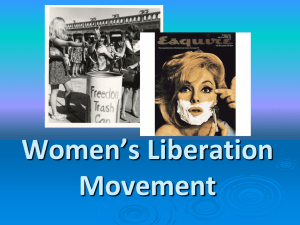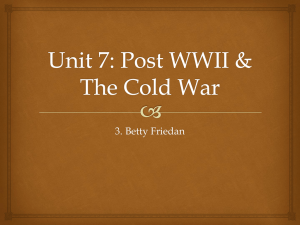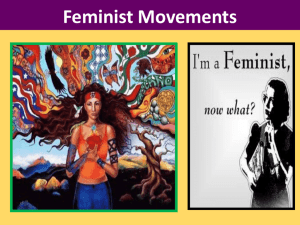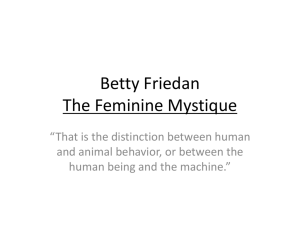Betty Friedan Life Childhood Bettye Naomi Goldstein was born on
advertisement
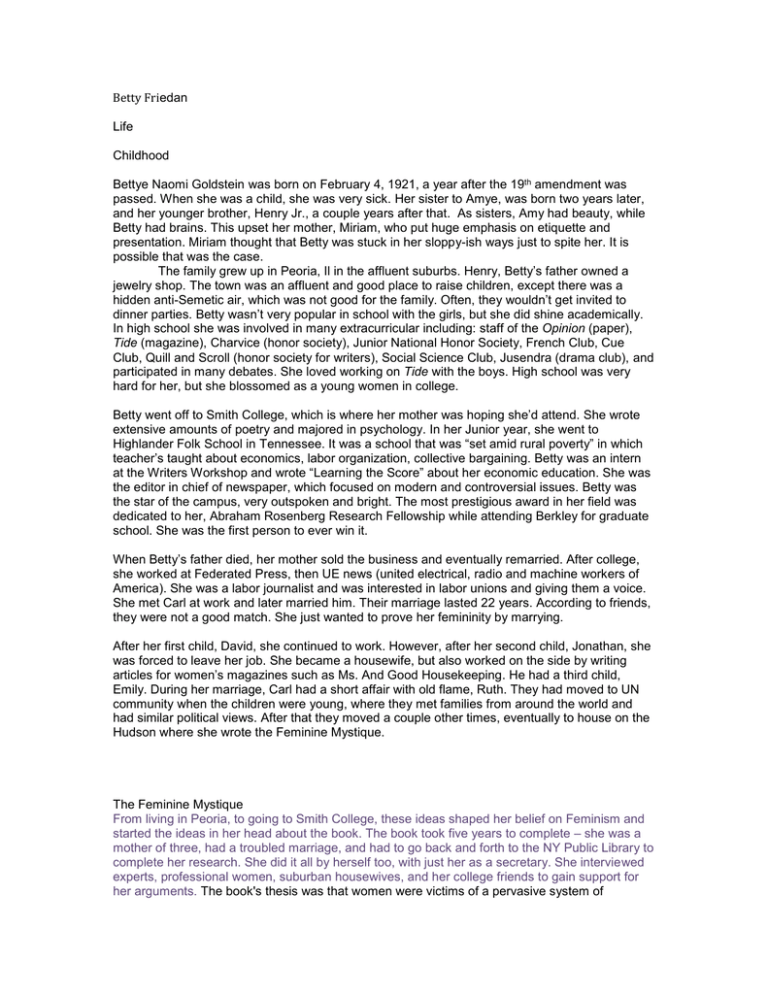
Betty Friedan Life Childhood Bettye Naomi Goldstein was born on February 4, 1921, a year after the 19th amendment was passed. When she was a child, she was very sick. Her sister to Amye, was born two years later, and her younger brother, Henry Jr., a couple years after that. As sisters, Amy had beauty, while Betty had brains. This upset her mother, Miriam, who put huge emphasis on etiquette and presentation. Miriam thought that Betty was stuck in her sloppy-ish ways just to spite her. It is possible that was the case. The family grew up in Peoria, Il in the affluent suburbs. Henry, Betty’s father owned a jewelry shop. The town was an affluent and good place to raise children, except there was a hidden anti-Semetic air, which was not good for the family. Often, they wouldn’t get invited to dinner parties. Betty wasn’t very popular in school with the girls, but she did shine academically. In high school she was involved in many extracurricular including: staff of the Opinion (paper), Tide (magazine), Charvice (honor society), Junior National Honor Society, French Club, Cue Club, Quill and Scroll (honor society for writers), Social Science Club, Jusendra (drama club), and participated in many debates. She loved working on Tide with the boys. High school was very hard for her, but she blossomed as a young women in college. Betty went off to Smith College, which is where her mother was hoping she’d attend. She wrote extensive amounts of poetry and majored in psychology. In her Junior year, she went to Highlander Folk School in Tennessee. It was a school that was “set amid rural poverty” in which teacher’s taught about economics, labor organization, collective bargaining. Betty was an intern at the Writers Workshop and wrote “Learning the Score” about her economic education. She was the editor in chief of newspaper, which focused on modern and controversial issues. Betty was the star of the campus, very outspoken and bright. The most prestigious award in her field was dedicated to her, Abraham Rosenberg Research Fellowship while attending Berkley for graduate school. She was the first person to ever win it. When Betty’s father died, her mother sold the business and eventually remarried. After college, she worked at Federated Press, then UE news (united electrical, radio and machine workers of America). She was a labor journalist and was interested in labor unions and giving them a voice. She met Carl at work and later married him. Their marriage lasted 22 years. According to friends, they were not a good match. She just wanted to prove her femininity by marrying. After her first child, David, she continued to work. However, after her second child, Jonathan, she was forced to leave her job. She became a housewife, but also worked on the side by writing articles for women’s magazines such as Ms. And Good Housekeeping. He had a third child, Emily. During her marriage, Carl had a short affair with old flame, Ruth. They had moved to UN community when the children were young, where they met families from around the world and had similar political views. After that they moved a couple other times, eventually to house on the Hudson where she wrote the Feminine Mystique. The Feminine Mystique From living in Peoria, to going to Smith College, these ideas shaped her belief on Feminism and started the ideas in her head about the book. The book took five years to complete – she was a mother of three, had a troubled marriage, and had to go back and forth to the NY Public Library to complete her research. She did it all by herself too, with just her as a secretary. She interviewed experts, professional women, suburban housewives, and her college friends to gain support for her arguments. The book's thesis was that women were victims of a pervasive system of delusions and false values that urged them to find their fulfillment and identity vicariously, through their husbands and children. Later Betty wrote about her book, “in a certain sense, it was almost accidental – coincidental – that I wrote the Feminine Mystique and in another sense my whole life had prepared me to write that book; all the pieces of my own life came together for the first time in the writing of it.” The book, however, was not the first radical book about feminism and women’s rights. Apparently Betty didn’t credit Simone de Beauvoir’s “The Second Sex.” Whatever the case, it became a national bestseller and was translated into about a dozen languages. Feminine Mystique – a revolutionary book uncovering the "the problem that has no name," for housewives in the 1950’s. This book started the second wave of the feminist movement, which pushed women to fight for equality in the workforce. It is a national bestseller, Quotes The Problem lay buried, unspoken, for many years in the minds of American women. It was a strange stirring, a sense of dissatisfaction, a yearning that women suffered in the middle of the twentieth century in the United States. Each suburban wife struggled with it alone. As she made the beds, shopped for groceries, matches slipcover material, ate peanut butter sandwiches with her children, chauffeured Cub Scouts and Brownies, lay beside her husband at night – she was afraid to ask even of herself the silent question – “Is this all?” Reviews “The Feminine Mystique stated the trouble with women so clearly that every woman could recognize herself in the diagnosis…Things are different between men and women because we now have words for the trouble. Betty gave them to us.” - Caroline Bird, author of Lives of Our Own: Secrets of Salty Old Women and Second Careers: New Ways to Work After Fifty “ The book that pulled the trigger on history.” - Alvin Toffler, author of Future Shock Life So Far: A memoir She takes us inside her head to tell us the journey that included writing the bestselling novel, The Feminine Mystique. We follow her journey from childhood to starting the organization NOW and beyond. Library Journal Now in her late 70s, Friedan reminisces over a life of social activism that has included helping to found the National Organization for Women, the National Abortion and Reproductive Rights Action League, and the National Women's Political Caucus, as well as writing the pivotal The Feminine Mystique. She chronicles the successes of the women's movement but also the extremism and divisiveness within the movement that she feels took attention away from mainstream basic issues like childcare and equal pay for work of comparable value. Of her reputation for being ill-tempered and feisty, she claims that she has mellowed, though she concedes that this may be a lapse of memory on her part. Friedan's frank memoir complements two recent studies: Judith Hennessee's Betty Friedan, Her Life (LJ 3/15/99) and Daniel Horowitz's Betty Friedan and the Making of "The Feminine Mystique" (Univ. of Massachusetts, 1998). Her book belongs in every women's studies and academic collection as well as most public libraries. [For an interview with Friedan, see p. 112.--Ed.]--Patricia A. Beaber, Coll. of New Jersey, Ewing Copyright 2000 Cahners Business Information.\ It Changed My Life: Writings on the Women's Movement This book is a collection of reports of anti-feminism in the workforce from sex discrimination to the creation of the National Organization of Women, which retells stories of a variety of womens’ struggles, including Betty herself. On Women Turning 50: Celebrating Mid Life Discoveries This novel is filled with beautiful photographs of powerful women along with interviews about the challenges, triumphs, and discoveries of fifty-something year old women reflecting on work, family, and personal growth. Second Stage Betty argues a radical idea that men and women shouldn’t have to fit into stereotypical roles when relating to childcare. Maybe the solution iss that both the man and women split childcare and housework to preserve the family. The Fountain of Age This book celebrates the act of aging and finding purpose way beyond “mid-life.” Betty shares her experiences with aging and recounts other people’s discoveries and experience of aging. Library Journal Friedan tackles the subject of aging with the same candor evident in her earlier critiques of women's roles (e.g., Feminine Mystique , 1963). She offers no quick fixes on how to grow old gracefully in a society that worships youth. Instead, she confronts the reality of aging. This proves to be less frightening and damaging than the denial and cosmetic fix-ups to prolong youth in a culture that places no value on age and provides no role for its elders. Make waves, make new roles, and reclaim old roles, admonishes Friedan. She interweaves the newest research on aging and psychology with her own personal experience of coming to terms with aging. She does not give into stereotypes but instead suggests vital alternatives that acknowledge the need to act one's age in a meaningful way. A true pioneer, she brings to this important topic her wisdom, strength, and courage gained from years of living. This program has something for listeners of all ages. Highly recommended.-- Nancy Paul, Brandon P.L., Wis. Legacy - with her book, she revolutionized feminism in the 1960’s. no longer were housewives left with the emptiness and alone feeling. They realized that their friends felt the same way Began to get jobs/side projects NOW – 1966 National Organ for Women 1971 – National Women’s Political Caucus Today women are still working for equality, but we are almost there. Even though men get higher level jobs more frequently and are still paid more, we have come a long way. Stat- more women graduate from college Men have taken on more of the housework Child care is split Better support systems for each other Numerous women world leaders Continual support for young women to get education, jobs, fulfill dreams http://www.americanwriters.org/writers/friedan.asp barnesandnoble.com http://jwa.org/encyclopedia/article/friedan-betty
